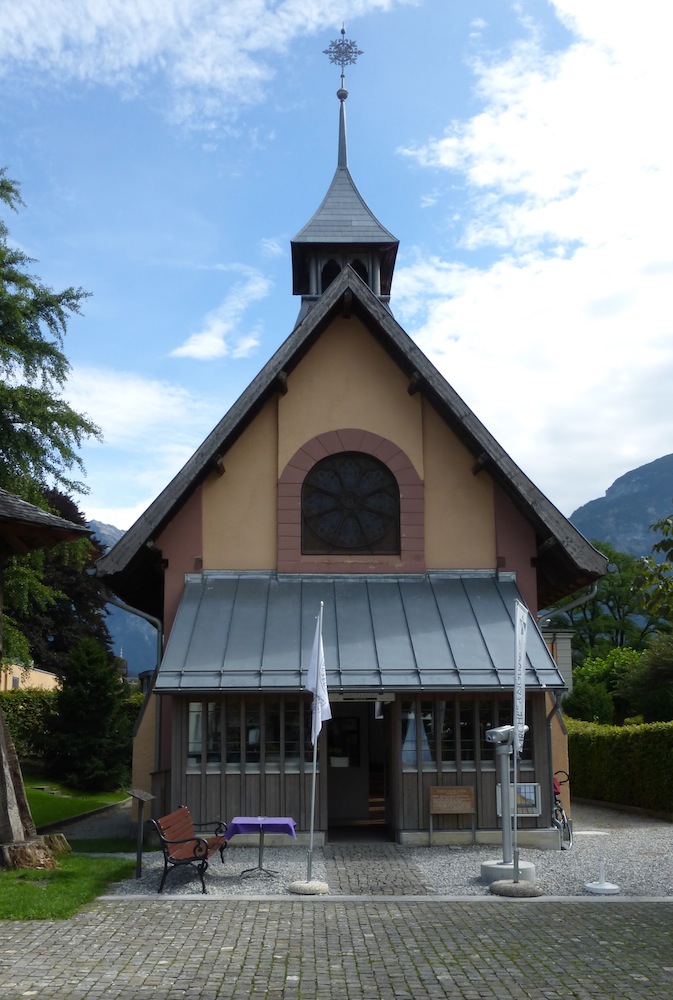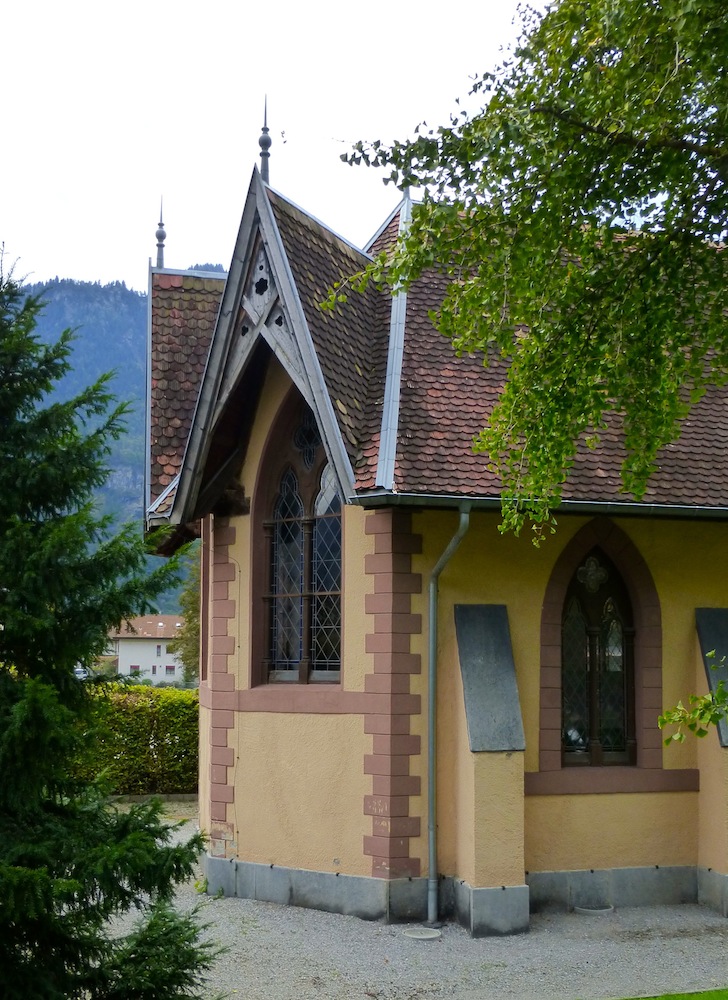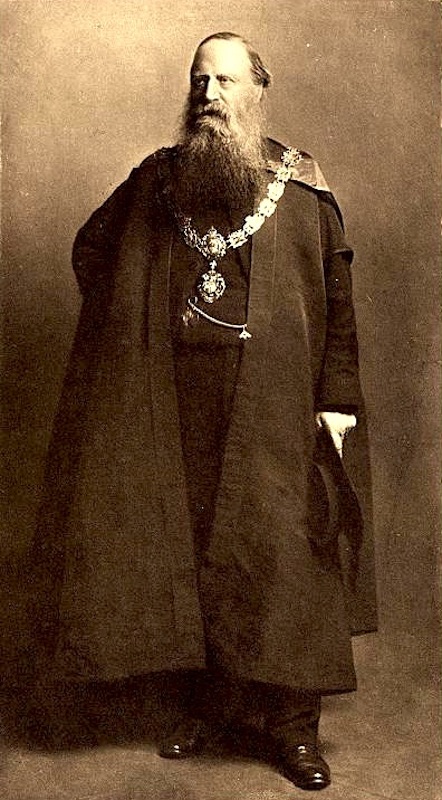Photographs and image scan by the author. You may use these without prior permission for any scholarly or educational purpose as long as you (1) credit the photographer or source and (2) link your document to this URL or credit the Victorian Web in a print document. [Click on the pictures to enlarge them.]

The English Church, Meiringen.
The English Church, 1868, rebuilt 1891; the original designed by Arthur Billing (1824-96). Town Square, Meiringen, Switzerland. This little Gothic gem was built in 1868 for the Rev. C. J. May, who had been chaplain to the British in this popular Alpine resort for nineteen years, to replace an earlier one "which was found to be too decayed to admit of restoration" ("Reuter's Telegrams"). The architect is given in this source as "a Mr Billing, Tooley Street, London." This is most likely Arthur Billing (1824-96), partner of Arthur Shean Newman (1828-73), who practised from 185 Tooley Street, London Bridge. Billing had been an assistant to Benjamin Ferrey (see "Arthur Billing"). Designing this little Gothic Revival church would have been a pleasant exercise for him. The church was built on a site given by M. Edourd Baud, proprietor of the Sauvage Hotel (now the Park Hotel du Sauvage), beside his hotel's garden — the edge of the hotel building, painted the same yellow ochre colour, can be seen on the left of the photograph above. It was dedicated on 2 August of that year. The Queen herself sent 1,250 francs for the finishing of "the beautiful new English church," and a further £200 was solicited to complete the work ("Reuter's Telegrams").



Left to right: (a) West entrance (now with lean-to porch). (b) View of the north-east corner, with one side of the gabled east end. (c) View from above (from a hotel window overlooking the church).
The church has undergone some changes over the years. It was one of the few buildings to survive the first of two devastating fires to hit Meiringen. That was in 1879. But it succumbed to the other, in the autumn of 1891, and had to be rebuilt on its old foundations. Although the main part looks the same (including the tower), the unusual triple-gabled east end may date from that time, since this is not seen in an old photograph of it (see "The English Church"). The first church service in the rebuilt church was held by Reverend Dr. J. Payne in 1893. The lean-to porch looks like a much more recent addition.
Interior



Left to right: Attractive rose window, with (perhaps) Alpine roses. (b) Lovely, not too elaborate, hammer-beam roof. This looks recently restored. (c) Side window with quarries, red border and matching quatrefoil above.
The main part of the church is bright and airy, lit by handsome windows, and with a particularly splendid roof. From these features it would seem that the interior was very pleasant, but is hard to visualise it now because it has been deconsecrated and is used as an exhibition space: partitions have been inserted, and of course the church fittings have been removed.
"Woolwich on the Alps"

The Rev. John William Horsley, who held the summer chaplaincy at the church for many years. Source: Horsley, frontispiece.
Over the years, the little English Church has ministered to countless visitors. The first fire was widely reported in the British press, with one account noting that the little Swiss town was "a household word" in many British households, "associated with many pleasant memories of holiday travel" ("Disaster in Oberland"). But the person most responsible for taking the church's role through into the next century was the Rev. John W. Horsley (1845-1921), Vicar of Holy Trinity, Woolwich, who came out as summer chaplain for the first time in June 1891, shortly before the second fire. A marvellously larger-than-life figure with an immense amount of enthusiasm for both social reform and natural history, Horsley was delighted with the place, and soon got the idea of bringing out parties of his parishioners:
turning my thoughts to grimy Woolwich, I began to consider whether "Woolwich on the Alps" was an impossibilty, and to imagine how it might delight and educate those whose holiday was usually spent at Clacton-on-Sea or Margate at the best.... Next summer, therefore, found me personally conducting a party of fifty-one, mainly from Woolwich and Plumstead, of all ages and of both sexes; and this had developed each year until I had to limit my party to one hundred and forty, which was the accommodation of the dining-room at the hotel. [149]
Horsley, who later became Rector of St Peter's Walworth, Mayor of Southwark and Honorary Canon of first Rochester and then Southwark Cathedral, continued to hold his chaplaincy in Meiringen, and bring out his own parishioners and others, for many years. In this way, he explains, he introduced "more than a thousand friends from all parts ... (most of them for the first time) to this land — the best playground, and the schoolroom of Europe." He adds that he has become "an expert in and a lecturer on the Bernese Oberland, a member of the Swiss Alpine Club, and a sort of Consul for Meiringen in England" (150). Such was his enthusiasm that he ended this part of his reminiscences with a long poem about the place, enthusing over the local scenery and including in the refrain a rousing "Hurrah for Meiringen!" During this period the church maintained a connection with royalty: Queen Mary visited it in 1903.
The English Church and Meiringen Today
The church still keeps its association with England. A popular Sherlock Holmes Museum is housed in the basement area, since the church is near the Reichenbach Falls, where Holmes and the arch-villain Moriarty fall (supposedly) to their deaths in "The Final Problem." Holmes would be resurrected later, by popular demand. The town square area between the church and the main road also holds memories of those famous Victorians who visited and indeed helped to popularise Meirengen. It sports an English-looking street sign naming it "Conan Doyle Place," and a splendid seated statue of Sherlock Holmes by John Doubleday (b. 1947), installed in 1988. The square is about to be graced also by a monumental sculpture group of the celebrated Alpine guide, Melchior Anderegg, leading a young Sir Leslie Stephen up a rock face in the early years of Alpine mountaineering — a sport that Stephen himself helped to establish. This is by a young contemporary Swiss sculptor, Clarissa Kessler.
Related Material
- The Reichenbach Falls
- Sir Arthur Conan Doyle in Switzerland
- Sir Leslie Stephen and Alpine Mountaineering
Sources
"Arthur Billing." Dictionary of Scottish Architects. Web. 22 October 2014.
Brodie, Antonia. Dictionary of British Architects 1834-1914. Vol. 2, L-Z. London: Continuum, 2001. See p.253, entry for "Newman, Arthur Shean, 1828-1873).
Chapman, H. B., rev. C. A. Creffield. "Horsley, John William (1845–1921)." Oxford Dictionary of National Biography. Online ed. Web. 22 October 2014
"Disaster in Oberland." The Morning Post. 17 February 1879. British Library: 19th Century British Newspapers. Web. 22 October 2014.
"The English Church, Meiringen." Sherlock Holmes Museum. Web. 22 October 2014.
Horsley, John William. "I Remember": Memories of a "Sky Pilot" in the Prison and the Slum. London : W. Gardner, Darton & Co., 1911. Internet Archive. Contributed by Robarts Library, University of Toronto. Web. 22 October 2014.
Museum Catalogue, compiled by Guy Marriott. Meiringen, Switzerland: Sherlock Holmes Museum, 2012.
"Reuter's Telegrams." The Morning Post. 10 September 1868: 5. British Library: 19th Century British Newspapers. Web. 22 October 2014.
Last modified 22 October 2014